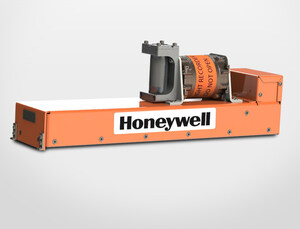PHOENIX, May 11, 2011 /PRNewswire/ -- Addressing the needs of airlines around the world to maximize safety, reduce operating costs and gain efficiencies, Honeywell (NYSE: HON) today announced industry-first certification and immediate availability of its advanced traffic collision avoidance system (TCAS) with SmartTraffic.
(Logo: http://photos.prnewswire.com/prnh/20080425/LAF040LOGO)
TCAS with Honeywell SmartTraffic improves traffic situational awareness and increases flight safety and efficiency, leading to significant cost savings for airlines. Airbus is the first to certify the new system and plans to offer these advanced functions on its A320, A330 and A340 models.
"The new TCAS system is a significant step towards worldwide Air Traffic Management (ATM) modernization, which is designed to make flights safer, more environmentally friendly and more affordable," said John Bolton, president of Honeywell's Air Transport and Regional business. "Airlines that use TCAS with SmartTraffic will be flying planes equipped with the most advanced collision avoidance in the world. This will considerably increase their flight efficiency and routing, and in so doing, reduce their costs substantially."
Leveraging Automatic Dependent Surveillance-Broadcast (ADS-B) technology, TCAS with SmartTraffic encapsulates and delivers super-advanced Hybrid Surveillance and Airborne Traffic Situational Awareness (ATSAW) functionality, which provides a much more intuitive display of what is in a plane's airspace. Taking advantage of the improved system requires a simple software upgrade to airlines' current TCAS systems with no need to replace or overhaul existing equipment. Unique to Honeywell, and a key differentiator, is that the system is the only such offering that does not require new TCAS hardware, saving airlines more than $25,000 per aircraft upgrade compared to competitors' traditional products.
ATSAW Reduces Cost of Operations for Airlines
The spiking cost of fuel is the number one threat to an airline's business. For instance, every penny increase costs airlines $175 million, according to the Air Transport Association. To reduce those costs and maintain profitability, airlines have to find ways to be more efficient. TCAS with SmartTraffic gives them a big solution to this vexing problem, enabling airlines to substantially reduce operational costs while enhancing flight safety.
For example, TCAS with SmartTraffic enables an airline to incorporate the In Trail Procedure (ITP) on a trans-oceanic flight. ITP is designed to reduce oceanic and remote area aircraft separation by allowing planes to obtain a more efficient routing while maintaining a safe, yet reduced distant from neighboring traffic. With the system, pilots can choose a more efficient altitude during transoceanic flight routing and move to adopt that route more quickly than with traditional TCAS systems. Just the ability to simply change routes can enable annual fuel savings of up to $100,000 per aircraft, adding up to millions of dollars across an average airline's operational fleet.
TCAS with SmartTraffic also enhances visual separation on approach so that more aircraft can land safely in a tighter timeframe. This can substantially improve on-time efficiency and turn-around performance, benefitting both passengers and airlines.
Improving Flight Safety and Situational Awareness
TCAS with SmartTraffic uses ADS-B, a highly accurate satellite-based system that provides more information than TCAS-only systems. It improves overall flight safety and increases airspace capacity by automatically broadcasting aircraft position and other relevant information periodically to ground stations and other aircraft without pilot interaction.
Honeywell's TCAS system meets standards recommended by the International Civil Aviation Organization and reinforced by the Association of European Airlines as a global safety update for all TCAS systems. The system complies with the proposed European mandate of Change 7.1 and includes a unique hybrid surveillance technology that improves long-range situational awareness, and mitigates the risk of a potential mid-air collision by addressing key safety hazards and providing a clear course of action.
Honeywell has pioneered TCAS developments since the mid-1950s.
Based in Phoenix, Arizona, Honeywell's aerospace business is a leading global provider of integrated avionics, engines, systems and service solutions for aircraft manufacturers, airlines, business and general aviation, military, space and airport operations.
Honeywell International (www.honeywell.com) is a Fortune 100 diversified technology and manufacturing leader, serving customers worldwide with aerospace products and services; control technologies for buildings, homes and industry; automotive products; turbochargers; and specialty materials. Based in Morris Township, N.J., Honeywell's shares are traded on the New York, London, and Chicago Stock Exchanges. For more news and information on Honeywell, please visit www.honeywellnow.com.
Honeywell and the Honeywell logo are the exclusive properties of Honeywell International, Inc., are registered with the U.S. Patent and Trademark Office, and may be registered or pending registration in other countries. All other Honeywell product names, technology names, trademarks, service marks, and logos may be registered or pending registration in the U.S. or in other countries. All other trademarks or registered trademarks are the property of their respective owners. Copyright 2011 Honeywell.
This release contains certain statements that may be deemed "forward-looking statements" within the meaning of Section 21E of the Securities Exchange Act of 1934. All statements, other than statements of historical fact, that address activities, events or developments that we or our management intends, expects, projects, believes or anticipates will or may occur in the future are forward-looking statements. Such statements are based upon certain assumptions and assessments made by our management in light of their experience and their perception of historical trends, current conditions, expected future developments and other factors they believe to be appropriate. The forward-looking statements included in this release are also subject to a number of material risks and uncertainties, including but not limited to economic, competitive, governmental, and technological factors affecting our operations, markets, products, services and prices. Such forward-looking statements are not guarantees of future performance, and actual results, developments and business decisions may differ from those envisaged by such forward-looking statements.
SOURCE Honeywell Aerospace
WANT YOUR COMPANY'S NEWS FEATURED ON PRNEWSWIRE.COM?
Newsrooms &
Influencers
Digital Media
Outlets
Journalists
Opted In






Share this article